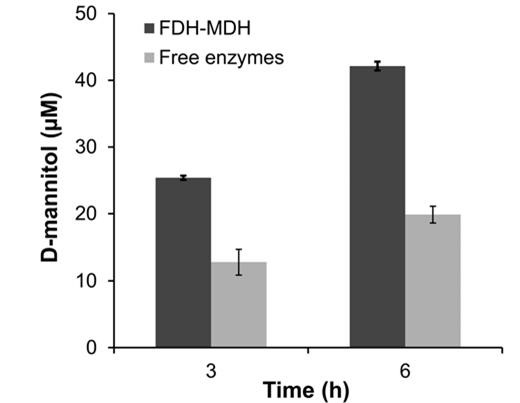Media Center
A multimedia mosaic of moments at GIST
GIST Excellence
A team led by Dr. Inchan Kwon develops a high-efficient environment-friendly enzyme complex bound by click chemistry
- 엘리스 리
- REG_DATE : 2015.09.04
- HIT : 893
Development of a high-efficient environment-friendly
enzyme complex bound by click chemistry

Figure1. Formate Dehydrogenase (FDH) (left green) and Mannitol Dehydrogenase (MDH) (right orange) are bound together through click chemistry. Taken a specific area of each FDH and MDH to attach a coupler and connect them together to make enzyme complex.
□ Korean researchers have succeeded in improving the efficiency of the bio-conversion processes to replace environmentally harmful chemical reactions by binding biocatalyst (enzyme) to a selective position by using click chemistry. Click chemistry is a specific binding reaction that quickly links two smaller molecules through their interaction to create larger molecules.

(from left) Professor Inchan Kwon, Ph.D candidate Sung In Lim, M.S.-Ph.D. Integrated Program candidate Jinhwan Cho
□ The research was led by professor Inchan Kwon of the School of Materials Science and Engineering and prepared by Ph.D candidate Sung In Lim at the department of Chemical Engineering, University of Virginia and M.S.-Ph.D. Integrated Program candidate Jinhwan Cho at the School of Materials Science and Engineering. The research was carried out with the support for mid-size business research promoted by the Ministry of Science, ICT and Future Planning and the National Research Foundation of Korea. The paper has been published in the July 2, 2015, online version of the Chemical Communications.

Figure 2. Mannitol is produced through the process of association reaction of FDH and MDH. NADH coenzyme is produced from the change of formate to carbon dioxide by FDH. NADH is then used to generate the Mannitol from fructose by MDH. Through these associations, Mannitol is produced from a low cost fructose that can be used in medicine.

Figure 3. This chart shows the comparison of the Mannitol production while FDH and MDH is combined (dark gray) and while in free state (light gray). Combined FDH and MDH produces twice as much Mannitol.
□ Professor Inchan Kwon said, “Currently developed technology can commonly be applied to bind the various biocatalyst. However, we hope to increase the efficiency of the bio-conversion process for cellulose degradation, CO conversion, methane conversion, and so on. This process is also expected to be useful in studying the mechanisms of active catalyst.”